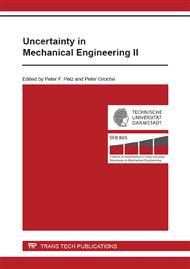[1]
S. M. Göhler, T. J. Howard, A Framework for the Application of Robust Design Methods and Tools, Proceedings of the First International Symposium of Robust Design 2014, pp.123-133, (2014).
Google Scholar
[2]
P. Andersson, A Process Approach to Robust Design In Early Engineering Design Phases, Department of Machine Design Lund Institute of Technology Lund, Lund, (1996).
Google Scholar
[3]
M. Ebro, T. J. Howard, J. J. Rasmussen, The foundation for Robust Design: Enabling Robustness through Kinematic Design and Design Clarity, INTERNATIONAL DESIGN CONFERENCE - DESIGN 2012, volume 2, p.817, (2012).
Google Scholar
[4]
R. Söderberg, L. Lindkvist and J. S. Carlson, Managing physical dependencies through location system design, Journal of Engineering Design, Vol. 17, No. 4, August 2006, 325–346.
DOI: 10.1080/09544820500275685
Google Scholar
[5]
G. Pahl, W. Beitz, J. Feldhusen, K.H. Grote, Engineering Design, London, (2007).
Google Scholar
[6]
T. Eifler, Modellgestützte Methodik zur systematischen Analyse von Unsicherheit im Lebenslauf technischer Systeme, Düsseldorf, (2015).
Google Scholar
[7]
K.T. Ulrich, S.D. Eppinger, Product Design and Development, New York, (2008).
Google Scholar
[8]
T. Freund et al., An Approach to analysing Interface Uncertainty using the Contact and Channel Model, International Conference on Engineering Design 2015, (2015).
Google Scholar
[9]
A. Albers, M. Ohmer, Engineering Design in a different way: Cognitive Perspective on the Contact & Channel Model Approach, Visual and Spatial Reasoning in Design III, pp. (3-21), (2006).
Google Scholar
[10]
S. Matthiesen, A contribution to the basis definition of the element model Working Surface Pairs & Channel and Support Structures, about the correlation between layout and function of technical systems, (2002).
Google Scholar
[11]
K. Roth, Konstruieren mit Konstruktionskatalogen, Springer Verlag, Heidelberg, (1982).
Google Scholar
[12]
VDI2221 – Systematic Approach to the Design of Technical Systems and Products, Düsseldorf, (1987).
Google Scholar
[13]
J. Mathias, Selection of Physical Effects based on Disturbances and Robustness Ratios in the early Phases of Robust Design, International Conference on Engineering Design 2011, pp.324-335, (2011).
Google Scholar
[14]
N.P. Suh, The Principles of Design, New York, (1990).
Google Scholar
[15]
R. A. Engelhardt, Uncertainty Mode and Effects Analysis – heuristische Methodik zur Analyse und Beurteilung von Unsicherheiten in technischen Systemen des Maschinenbaus, Darmstadt/ Technische Universität Darmstadt, (2013).
Google Scholar
[16]
J. Mathias, Strategies and Principles to Design Robust Products, International Design Conference - Design 2012, pp.341-350, (2012).
Google Scholar
[17]
T. Freund et al., Modelling Use Phase Variability and its Application in Robust Design and Eco Design, International Design Conference - Design 2014, pp.1063-1072, (2014).
Google Scholar
[18]
T. Freund, Robust Design of Active Systems - An Approach to Considering Disturbances within the Selection of Sensors, Proceedings of the international symposium on robust design – ISORD'14, pp.137-147, (2014).
Google Scholar


